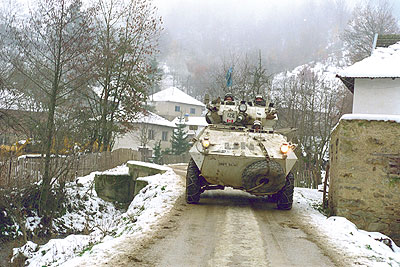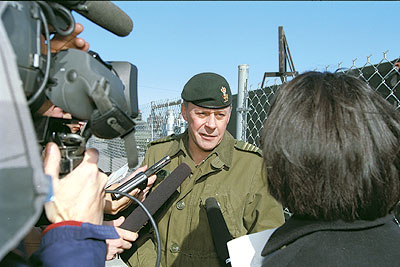
Canadian Peacekeeping in Former Yugoslavia
In the 1990s, UN peacekeeping missions were Canada's primary overseas commitment, with personnel stationed in more than a dozen countries. After 1992, tens of thousands of Canadians served as soldiers, negotiators, and aid workers in the former Yugoslavia.
Following the death of Yugoslav leader Marshal Tito in 1980, and the end of the Cold War in 1989, Yugoslavia’s six republics were divided by the rise of nationalist-separatist groups. Slovenia declared independence in 1991, followed soon after by Croatia and Bosnia. Serbia’s president Slobodan Milosevic tried to restore the federal state under his own leadership, but the resulting Yugoslav wars of 1991-1995 were soon characterized by murderous violence and ethnic cleansing. During this conflict, some 2 million people lost their homes and 200,000 died.

UN Mission in Croatia
Croatia’s declaration of independence soon produced civil warfare within its new borders. Inside Croatia, the breakaway “Republic of Serbian Krajina” – supported by the Yugoslav National Army (JNA) – included the Medak Pocket, a fertile farming region that extended deep into official Croatian territory.
In February 1992, Canada contributed a battalion-sized unit to the 14,000-strong United Nations Protection Force (UNPROFOR), with the intent of enforcing a peace settlement in Croatia. This commitment was larger and more dangerous than previous Canadian peacekeeping roles during the Cold War. Due to the unpredictability of Croatian troops, and those of the JNA-supported Serb minority, Canada’s blue-helmeted soldiers needed to be more heavily armed than on traditional peacekeeping operations.

The Canadian mission fell under Chapter Six of the UN Charter: settlement of disputes using the minimum of force, except in self-defence. The difficulty was that the truce in Croatia was extremely fragile, with centuries-old animosities between the Croat and Serb inhabitants being inflamed by powerful nationalist sentiments. The reality on the ground was that there was little “peace” to keep.
2 PPCLI Battalion
In March 1993, the Canadian battle group – 875 troops including regulars from 2 PPCLI and a large component of reservists – arrived for its first six-month tour in Croatia. There they encountered renewed aggression, as Croat and Serb forces engaged in ethnic-cleansing campaigns aimed at removing or killing any residents of the opposing side.
Two companies of Canadian soldiers were assigned to the dangerous rural areas, and then to the Medak Pocket – a strategic salient, or bulge, along the frontline between Serb and Croat forces. Here, the Canadians were to guarantee the truce and oversee the safe return of refugees to their pre-war homes. From the outset, however, the peacekeeping force encountered machine gun and mortar fire and was occasionally threatened by ambushes and booby-traps. With 15,000-18,000 thousand Serb soldiers remaining in the officially “demilitarized” zones, the goal of the Croatian Army was to drive them out. Caught between the two sides were the Canadians, who were now considered an obstacle by both Croats and Serbs.
Fighting in Medak Pocket
On 9 September 1993, as lead elements of 2 PPCLI moved through the Serbian lines to take up their assigned positions in UN Sector South, Serb civilians were fleeing for their lives just ahead of a Croatian infantry attack against the Medak Pocket. The Canadians, reinforced by two mechanized infantry companies from the French army, built defensive positions until a new ceasefire could be reached. Meanwhile the Serb and Croat forces exchanged more than 6,000 artillery and rocket shells.
On 13 September, international pressure and UN negotiations produced the “Medak Pocket Agreement” in which all parties agreed to return to their pre-9 September lines. However, on 15 September, the Croats began firing on the Canadian trenches, with machine guns, rifle grenades and mortars. A second attack came that night, this time far more severe. The Canadians returned fire with all the force they could muster.
In the worst of the fighting, Sergeant Rod Dearing’s section of troops on Charlie Company’s left was forced to repel five separate Croat attacks. Canadian and French troops withstood artillery fire and defended against smaller attacks throughout their lines. As many as 27 Croats were killed and four Canadians wounded. Although the Croatian army subsequently attributed these deaths to Serbian fire, it remains unknown whether the Canadians contributed to the total.
Aftermath
On 16 September, the Croats finally began to pull out of Medak. A tense standoff ensued when the Canadians were prevented from entering the devastated area until a new agreement came into effect at 1200 hours, at which time the Croatian army ignored the ceasefire terms and refused entry to the area until 1330. Although the peacekeepers had reason to suspect the delay was being used to complete the ethnic cleansing of the region, they were powerless to move in.
The Croats finally retreated following negotiations, in which 2 PPCLI’s commander, Lieutenant-Colonel James Calvin, resorted to the threat of international media exposure if the Croats did not adhere to the terms of their agreement. Upon searching the Medak Pocket, the exhausted Canadians were horrified to find no survivors. Instead, they found evidence of mass executions and the removal of bodies. The task now remained to diligently record and photograph remaining signs of torture and murder. Meticulous measures taken by 2 PPCLI to record evidence of ethnic cleansing later became standard procedure for UNPROFOR in preparing for war crimes trials.
Accomplishments
The Battle of Medak Pocket was the most significant fighting Canadian forces had engaged in since the Korean War. Although the Canadian public did not immediately recognize the nature or scale of this engagement, in 2002 Governor General Adrienne Clarkson awarded 2 PPCLI the Commander-in-Chief Unit Commendation, recognizing the unit’s performance of extraordinary deeds to the highest standard in extremely hazardous circumstances. The battalion was also awarded the UN Force Commander’s Commendation, one of only three such awards in UNPROFOR’s history.
The battle changed the face of peacekeeping, as the UN came to recognize the necessity of heavily-armed treaty enforcement in areas of continuing conflict.
Gradually, the Canadian government also realized the impact of post-traumatic stress disorder on its returning peacekeepers, and the necessity of proper debriefing and ongoing support for soldiers who have witnessed extreme brutality and human suffering. The haunting memories of the soldiers at Medak, many of them young reservists, affected returning troops for years to follow. The Armed Forces recognized Lieutenant Tyrone Green, Gunner Scott Leblanc, and Warrant Officer William Johnson for bravery. It also recognized Sergeant Rod Dearing for leadership, and awarded Lt.-Col. James Calvin the Meritorious Service Cross.


 Share on Facebook
Share on Facebook Share on X
Share on X Share by Email
Share by Email Share on Google Classroom
Share on Google Classroom

